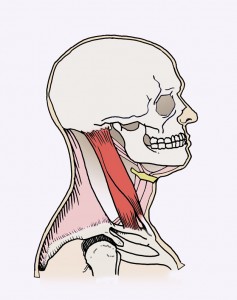Today we will look at a classic area of imbalance between muscles at the front and the back of the neck. A muscle at the front of the throat tilts and rotates your head – the sternocleidomastoid muscle, a big rope that connects your head (the mastoid), with the rib cage and shoulder girdle (the sternum and the clavicle).
We have a massive diamond shaped muscle on our back that stabilizes the shoulder blades on the back and aids in assorted movements of the blades—the trapezius, connected at the bases of the head, on either shoulder and much of the thoracic spine. All movements of the shoulders blade involve the trapezius in some way or another and it has some minor involvement with tilting and turning of the head.
The shoulder girdle hangs from these two muscles along with the omohyoid (considering the hyoid bone as part of the head). The shoulder girdle should be suspended above the rib cage. Neither the collar bones or the shoulder blades are meant to be in contact with the ribcage.
Forward head posture throws the relationship of these two muscles into disarray. When the head moves forward the spine goes with it. This pulls the shoulder blades forward as well, not only to they make contact with the upper ribcage, they begin to pull the ribcage forward as well.
The sternocliedomastoid muscle that should be involved in turning and nodding your head, instead is called upon to hold the head up in space. As a result the trapezius becomes largely responsible for turning and nodding the head.
Try to feel the difference of the two actions in your muscles.
- Let the head fall even more forward than usual and turn and nod the head.
- See if you feel that the muscular sensation of turning is generated from the back of the neck.
- Now pull the sides of the neck back, lengthen the ears back and up. What happens when you turn and nod your head here?
Ideally the focus of the effort changes from the back of the neck to the front of the throat where it should come from.
Forward head posture throws off a number of key relationships in the body, and for us the main culprits for forward head posture are a tucked pelvis and poor abdominal tone.
***


